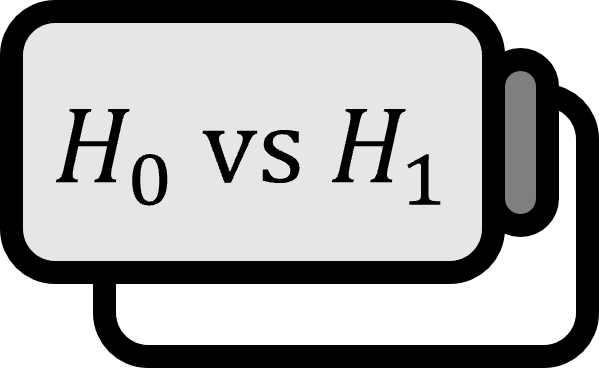ANOVA Table
Definition 1
A table summarizing the results from analysis of variance (ANOVA) is called an ANOVA table. The format of the ANOVA table may vary slightly depending on the experimental design.
Completely Randomized Design
| Source | df | SS | MS | F |
|---|---|---|---|---|
| Treatments | $k-1$ | SST | MST | MST/MSE |
| Error | $n-k$ | SSE | MSE | |
| Total | $n-1$ | TSS |
Randomized Block Design
| Source | df | SS | MS | F |
|---|---|---|---|---|
| Treatments | $k-1$ | SST | MST | MST/MSE |
| Blocks | $b-1$ | SSB | MSB | |
| Error | $(k-1)(b-1)$ | SSE | MSE | |
| Total | $n-1$ | TSS |
Explanation
The ANOVA table illustrates the process of calculating the $F$ statistic in analysis of variance. For undergraduates, it might initially seem like a mere memorization or computational task, but after some study, one will realize it ultimately involves deriving two values that follow a chi-squared distribution to obtain a value that follows an F-distribution. These fill-in-the-blank problems might seem challenging due to exams, but the genuinely important detail is the F statistic located at the top right of the table.
Calculation Method
Let’s calculate the figures in the ANOVA table in detail. Consider a completely randomized experiment with $k$ treatments, and from the $j$-th treatment, $n_{j}$ samples $x_{1 j} , \cdots , x_{n_{j} j}$ are obtained. For the total number of samples $n = n_{1} + \cdots + n_{k}$, consider the sample mean as $\bar{x} = \sum_{ij} x_{ij} / n$; the total sum of squares $\text{TSS}$ is expressed as follows. $$ \text{TSS} = \sum_{j=1}^{k} \sum_{i=1}^{n_{j}} \left( x_{ij} - \bar{x} \right)^{2} $$ Regarding the grand total $G = \sum_{ij} x_{ij}$, the correction for the mean $\text{CM}$ is as follows. $$ \text{CM} = {\frac{ 1 }{ n }} \sum_{j=1}^{k} \sum_{i=1}^{n_{j}} \left( x_{ij} \right)^{2} = {\frac{ G }{ n^{2} }} $$ The sum of squares for treatments $\text{SST}$ is obtained as follows using the sample mean for each treatment $j = 1 , \cdots , k$, expressed as $\bar{x}_{j}$. $$ \text{SST} = \sum_{j=1}^{k} n_{j} \left( \bar{x}_{j} - \bar{x} \right)^{2} $$ The sum of squares for error $\text{SSE}$ is derived using sample variance for each treatment $j = 1 , \cdots , k$ and obtained as a pooled variance. $$ \text{SSE} = \left( n_{1} - 1 \right) s_{1}^{2} + \cdots + \left( n_{k} - 1 \right) s_{k}^{2} = \text{TSS} - \text{SST} $$ Mean squares $MS$ are calculated by dividing each sum of squares $SS$ by the degrees of freedom, resulting in the value $MS = SS / \text{df}$. $$ \begin{align*} \text{MST} =& {\frac{ \text{SST} }{ k - 1 }} \\ \text{MSE} =& {\frac{ \text{SSE} }{ n - k }} \end{align*} $$ Finally, the $F$ statistic is calculated as the ratio of $MST$ to $MSE$ as follows. $$ F = {\frac{ \text{MST} }{ \text{MSE} }} = {\frac{ \text{SST} / (k - 1) }{ \text{SSE} / (n - k) }} $$
In a randomized block design, the number of blocks $b$ is added, along with the sum of squares for blocks $\text{SSB}$ and mean square $\text{MSB}$, and the degrees of freedom for $MSE$ change to $(b-1)(k-1)$. $$ \begin{align*} \text{SSB} =& \sum_{i=1}^{b} \left( x_{i} - \bar{x} \right)^{2} \\ \text{MSB} =& {\frac{ \text{SSB} }{ b - 1 }} \\ \text{MSE} =& {\frac{ \text{SSE} }{ (b-1)(k-1) }} \\ F =& {\frac{ \text{MST} }{ \text{MSE} }} = {\frac{ \text{SST}/ (k - 1) }{ \text{SSE} / (b-1)(k-1) }} = {\frac{ \text{SST}}{ \text{SSE} / (b-1) }} \end{align*} $$
Mendenhall. (2012). Introduction to Probability and Statistics (13th Edition): p452. ↩︎
